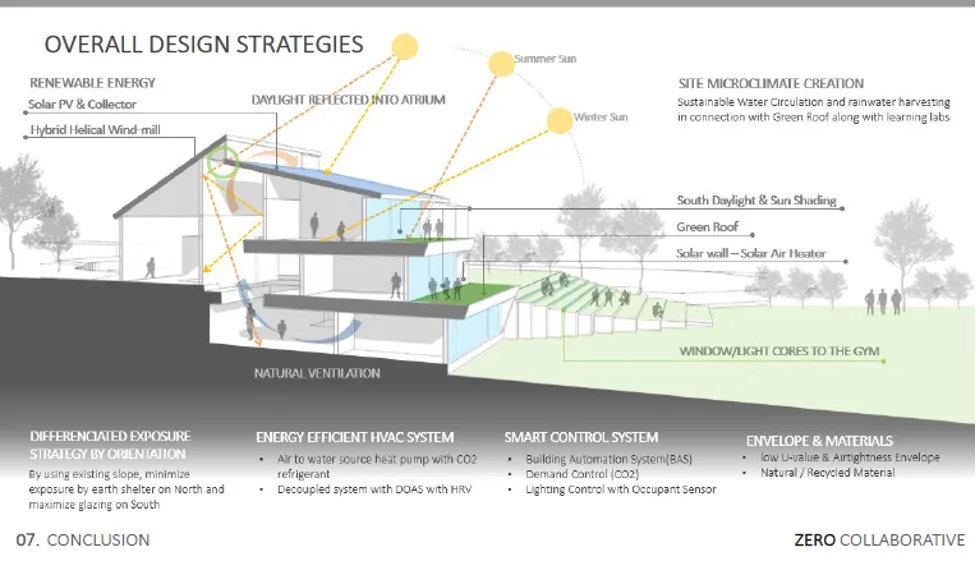HPB students compete in international design competition
A group of students in the Master of Engineering Leadership (MEL) in High Performance Buildings entered their capstone project into an international design challenge – and they were invited to compete in the finals in April 2023.

Students in the High Performance Buildings program complete two capstone projects over the course of their degree, including one that that involves developing an energy system for a building that is under design.
Jiyan Pattharwala, Grace (Giyoung) Oh, Leo Fan and Gabriela Mercado designed an energy system for a new building for the Vancouver Waldorf School.
As the students began working on the project, Jiyan says he realized that there was considerable overlap between the requirements of the capstone project and the requirements for the renowned U.S. Department of Energy Solar Decathlon Design Challenge.
“I knew that if we pursued this we would need to go quite a bit beyond the class requirements, but it seemed like a great opportunity to really push ourselves,“ says Jiyan, who was the student lead for the group.
Passive and Active Design Strategies
The MEL students reviewed the initial designs proposed by the school’s architect to come up with strategies that would provide a comfortable, healthy and inspiring school for students – a space that embodies best practices in energy efficiency, environmental performance and resiliency.
“We began with a passive first approach to lower the building’s energy requirements as much as possible,” says Jiyan.
The passive features they incorporated into the design included daylighting, natural ventilation and building orientation.
Grace took the lead role on passive design based on site analysis, environmental understanding and the client’s requirements.
“I think passive design should be considered first in sustainable architecture before adopting active strategies and that a deep and broad understanding of the site and environment is fundamental to find passive strategies,” she says.
“The key to achieving high performance buildings is using the surrounding natural elements and effectively responding to the constraints in nature.”
Leo took the lead on the active design elements – heating and cooling, ventilation, energy-efficient equipment like LED smart lights and monitoring, and clean energy generation.
Low-energy technologies were selected, such as a ground source heat pump that can offer low- or zero-carbon heating and cooling.
Gabriela was in charge of sustainability and resiliency strategies, along with energy modelling to identify the best combination of passive and active solutions.
Climate Resilience and Community Impact
“The challenges we’re designing for are considering future scenarios, solving issues that the school might have to deal in the future,” she explains.
“Some of them we’ve already experienced a little, like the heat dome in 2021, but others are not very evident but are equally important to be prepared for and to provide the school with the infrastructure to face them, such as flooding, drought periods and other hazards caused by climate change.”
The team used weather data models up to 2050 to make sure the strategies they are proposing today can meet future conditions.
“It was also important to us that the school itself become a learning experience for the students,” says Jiyan.
“This influenced design decisions, like foregrounding how we collect runoff water and reuse it. It also made us advocate for including helical wind mills on the site.
We know that they can’t generate all the school’s power needs, but having them there and meeting some needs empowers students to make tangible connections between energy generation and use.”
The team also considered how to make the school a valuable space beyond its primary purpose as a school. They created a separate block for the auditorium and gymnasium so it could be used by members of the community after hours and generate additional income for the school.
This area can also act as a shelter, complete with battery storage, during an earthquake or other natural disaster.
Advancing to the Finals
To prepare for the competition, the four students continued to meet weekly after they had completed the program, and they brought in additional support from other students in the program, as well as industry partners.
The semi-finals for the competition were held on February 21, 2022. Just under 20 teams competed in the educational division, giving an eight-minute presentation about the project and then answering questions from the jury.
The UBC team – known as ZERO COLLABORATIVE – was selected to advance to the finals, which will be held at the end of April in Golden, Colorado, at the US Department of Energy National Renewable Lab. (Read about the teams that are advancing to the finals.)
Jiyan says that the experience enabled him to draw on many of the skills he developed and strengthened in the technical and business classes.
“We had to give so many presentations during this program,” he says. “It has really improved my ability to write and deliver a strong script that follows a compelling storyline.”
The interdisciplinary nature of the group also enabled the students to broaden their understanding of challenges and solutions. “As an engineer, my analytical thinking approach and project design perspective is different from that of the architects in the group,” says Leo.
“I gained a much deeper appreciation of how high-level design concepts can and should guide project implementation.”
As Gabriela adds: “This program prepared me to think in a more holistic way, to see buildings not as an isolated thing but a part of a larger complex system. The MEL also provided me tools and frameworks for decision making and effectively communicating the business case for sustainability.”
Jiyan encourages all future High Performance Building students to consider using the capstone project as a stepping stone to entering the Solar Decathlon or other design challenges.
He says the feedback from the initial jury in the semifinals was very helpful, as have the connections he and other team members have made with industry partners.




